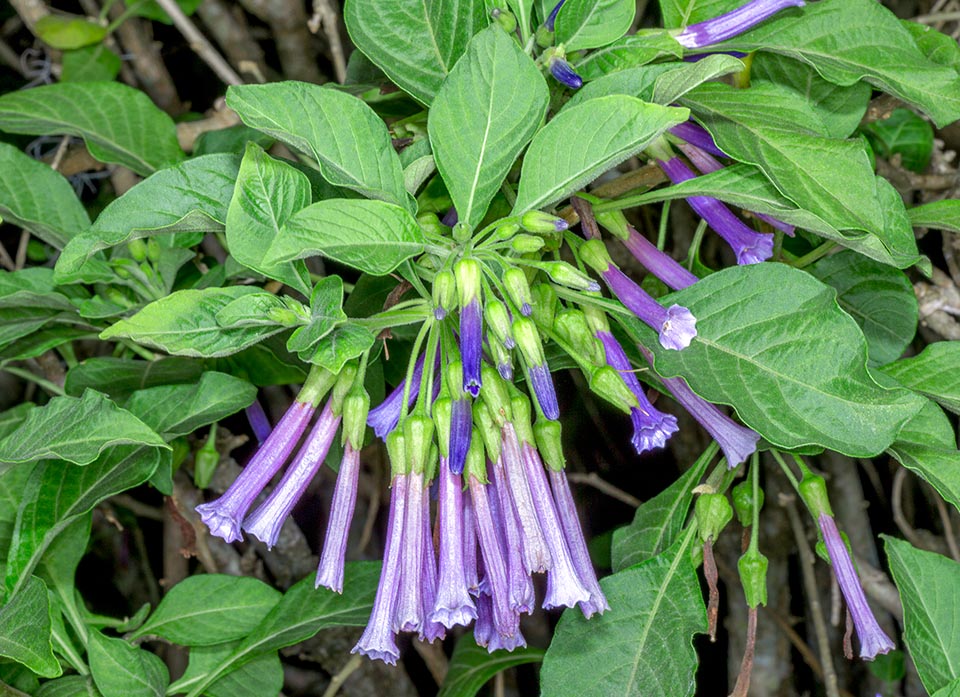Family : Solanaceae

Text © Pietro Puccio

English translation by Mario Beltramini
The species is native to Bolivia, Colombia, Ecuador and Peru where it grows in the mountain forests between the 1800 and the 2700 m of altitude.
The name of the genus is the combination of the Greek substantives “ἴον” (ἴon) = violet and “χρῶμα” (chrõma) = colour; the name of the species is the Latin adjective “cyaneus, a, um” = cerulean, deep blue, with reference to the colour of the flowers.
Common names: blue cestrum, violer bush, violet churcu, violet tubeflower (English); cestro blu (italian); churur violeta, iocroma, iocroma azul (Spanish); Royalblau glänzend (German).
The Iochroma cyaneum (Lindl.) G.H.M. Lawr. & J.M. Tucker (1955) is an evergreen shrub, deciduous in the less favourable climates, 1,2-3 m tall, very ramified, with pale brown stems and thin herbaceous branches. The leaves, on a 1,5-6 cm long grooved petiole, are simple, alternate, ovate to oblong-lanceolate with acute to obtuse apex and entire to sinuate margin, of pale green colour and slightly pubescent above, covered by a pale brown tomentum below in the initial phase of growth, then slightly pubescent, 8-18 cm long and 5-10 cm broad.
Axillary or terminal fasciculate inflorescences with numerous hanging flowers, on a 1-2,5 cm long pedicel, with 0,5-0,8 cm tubulous calyx, swollen at the base, with 5 unequal tiny teeth, persistent in fruit. Slightly curved tubulous corolla of pale violet to dark blue-violet colour, 3,5-4 cm long, with 5-10 lobes almost triangular, 1-2 mm long, 5 stamens and superior ovary. The flowers emit an intense fragrance in the late afternoon and in the evening and are pollinated by hummingbirds.
The fruit is an ovoid berry partially enclosed by the calyx, about 2 cm long and of 1,5 cm of diameter, of greenish yellow colour, containing several discoid seeds of about 1 mm of diameter.

Iochroma cyaneum is a shrub of Bolivia, Colombia, Ecuador and Peru. Blue-violaceous flowers, fragrant in the evening, pollinated by hummingbirds. Medicinal virtues © Giuseppe Mazza
Numerous varieties with different intensity of colour have been selected.
It reproduces by seed, that germinates in 1-3 weeks if fresh, placed superficially on draining organic loam maintained slightly humid, avoiding stagnation that may cause rottenness, at the temperature of 20-24 °C, and easily by semi-woody cutting and radical suckers in summer.
Species of easy cultivation, fast growth and almost continuous blooming, with a top in spring and in autumn, cultivable as isolated specimen for borders and hedges in the tropical, subtropical and in the mildest temperate warm regions, where it can stand temperatures up to about -4 °C, for a very short time, with possible loss of the aerial part, but revegetating from the base in spring. It requires full sun, or slight afternoon shade in the warmest climates, and fertile soils perfectly draining and aerated, maintained almost constantly humid, even if well rooted can bear short dry periods; useful are the prunings in late winter for getting a more compact posture. Cultivable also in pots to be sheltered in winter in the less favourable climates in a very luminous environment with lowest temperatures never under the 10 °C, with highest values around the 18-20 °C it can continue sporadically to bloom. Regular waterings in summer, more spaced in winter, allowing the upper layer of the loam to dry up, and monthly fertilizations, from spring to autumn, with a product specific for flowering plants in pots.
All parts of the plant are toxic if ingested, laboratory studies have evidenced the presence in various parts of the plant of bioactive compounds of potential pharmacological interest.
Synonyms: Habrothamnus cyaneus Lindl. (1844); Meyenia cyanea (Lindl.) Heynh. (1846); Iochroma lanceolatum Miers (1848); Iochroma weberbaueri Dammer (1918).
→ To appreciate the biodiversity within the SOLANACEAE family please click here.
